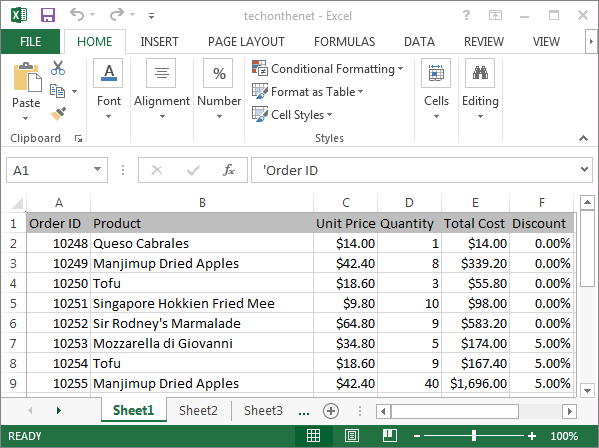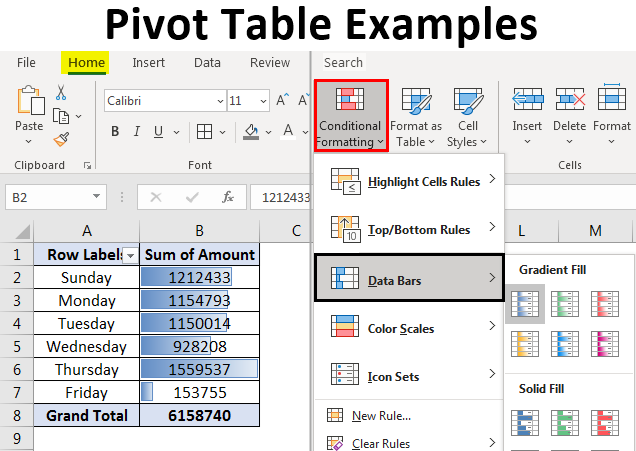

They are very easy to use and format and can be refreshed very quickly if the. Next in the VALUES section, click on the "Sum of Order ID" and drag it to the ROWS section.įinally, we want the title in cell A1 to show as "Order ID" instead of "Row Labels". Pivot tables within Microsoft Excel help you summarize large amounts of data quickly and efficiently. In this example, we've selected the checkboxes next to the Order ID and Quantity fields.
#HOW TO DO PIVOT TABLES IN EXCEL 2013 HOW TO#
Next, choose the fields to add to the report. Here we discuss how to Refresh Pivot Table in Excel using Top 4 methods with examples and downloadable template. When you create a pivot table in Excel 2013, you are taking data from your spreadsheet and inserting it into, by default, a new format in another sheet of your Excel workbook. Your pivot table should now appear as follows: A pivot table in Excel 2013 offers a variety of options for comparing data in columns, and grouping similar data in a way that would otherwise be difficult to do manually. In this example, we've chosen cells A1 to F16 in Sheet1. Select the range of data for the pivot table and click on the OK button. In the Tables group, click on the Tables button and select PivotTable from the popup menu.Ī Create PivotTable window should appear. Next, select the INSERT tab from the toolbar at the top of the screen. In this example, we've selected cell A1 on Sheet2.

Highlight the cell where you'd like to see the pivot table. Your browser can’t show this frame.Question: How do I create a pivot table in Microsoft Excel 2013?Īnswer: In this example, the data for the pivot table resides on Sheet1. Once you are done, it should look something like this: Now that the Pivot Table is complete, we need to publish it to Excel Services running on Sharepoint. I am assuming that you know how to do this, otherwise why are you reading this blog. This video shows you the steps in Excel 2007, to create the pivot table from multiple sheets, and set up a page field. Using the Pivot Table wizard in Excel, build a Pivot table to display some data. There are written instructions, and details on the pivot table limitations, on the Contextures website: Excel Pivot Table Tutorial - Multiple Consolidation Ranges Watch the Video The next step was to build a pivot table in the PowerPivot window, and that went well too. Once the PowerPivot tab was visible, I connected to the Excel file that had the sample data, without any problems. However, while you’re setting up the pivot table you can create one or more page fields, and create labels for the data ranges. Fortunately, that worked, and the PowerPivot tab showed up again, in Excel 2013. The pivot table from multiple sheets isn’t as flexible as a regular pivot table - all the data fields use the same summary function, and there’s only one row field. There’s no equivalent command on the Ribbon in Excel 2007, but you can press Alt+D, then type P to open the wizard. In this example, weve selected cell A1 on Sheet2. Highlight the cell where youd like to see the pivot table. In Excel 2003 you can open the PivotTable and PivotChart wizard by choosing Data | PivotTable and PivotChart Report. Question: How do I create a pivot table in Microsoft Excel 2013 Answer: In this example, the data for the pivot table resides on Sheet1. With traditional pivot tables, we don’t need to. In order to use DAX formulas, we will need to select the Add this to the Data Model option.

Select a cell inside the data go to the Insert tab then press the Pivot Table button. It’s better if the data is all on one sheet, but if you don’t have that option, multiple consolidation ranges will pull all the data into one pivot table. First, we will need to insert a pivot table. If Excel data is on different sheets, you can create a pivot table from multiple sheets, by using multiple consolidation ranges.


 0 kommentar(er)
0 kommentar(er)
